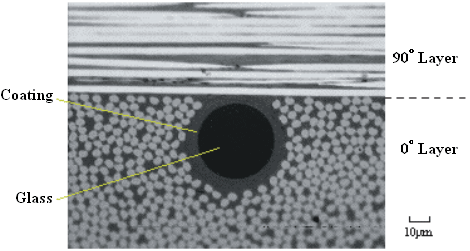 |
 |
|
|||||||||||||||||||||||||
|
| Developing Smart Composite Structures for Application to the Next-generation Japanese-Made Aircraft is My Dream. |
Nobuo Takeda, Prof., Department of Advanced Energy, Graduate School of Frontier Sciences Additional Post: Department of Aeronautics and Astronautics, School of Engineering Aircrafts require light and strong materials. CFRP (carbon-fiber reinforced plastics) with excellent properties are being extensively used to replace metals for the fuselage and wings of air crafts in service in the next 2 or 3 years. My research is concerned with smart materials able to carry out self-monitoring of damages and self-repairs, hoping to apply such material systems in aircrafts or satellites. We have developed unique small-diameter optic fibers measuring 40µm in diameter, one-third of the usual one, and are the first in the world to have succeeded in embedding these fibers in CFRP. When equidistant gratings are inscribed into the core of the glass optic fibers, light signals with a certain wave length are reflected and bounced back. This can be used as strain sensor called FBG (fiber Bragg grating) by analyzing the wavelength of this light and measuring the strain in the Bragg grating. Furthermore, the CFRP do not weaken in strength even with this type of FBG optic sensors embedded in CFRP structures. |
 CFRP laminate with embedded small-diameter fiber optic sensors. |
I decided to become a researcher after I saw the live broadcast of the launch of Apollo 11, when I was in my second year of senior high school. I had wanted to become a detective up to when I was in junior high, but gave up the idea because I was afraid of the sight of blood. I knew I was not gifted and would be better being a research engineer than a scientist, and have since been working on advanced composite materials research. In the course of that I began asking myself constantly what the originality of my research is. I wish for the young generation to always think about the originality of their own research. While today we can look up anything quickly on the Internet, I am concerned that many young people may be misled by the information they have obtained and forget to use their own thinking. It is vital for a researcher to come up with his or her own unique story and to explain it for others to understand. To this end, language skills will also be essential. I myself have also spent a fortune in my younger days to acquire the English language as a skill, and I found the repeated shadowing method being the most effective. When no ideas come to mind we can always turn to nature for inspiration. For instance, the reinforcing fibers of the bamboo to protect the branch are mainly distributed at the edges than in the middles burdened with weight when the bamboo is bent. Such amazing property of natural elements can unexpectedly offer hints. I find reading a great way to refresh my mind during my one-hour one-way commute. A recent book of interest is "The Da Vinci Code". The mystery books by the author Michael Connelly, a fellow student from The University of Florida, are my favorite. If I have free time then I go to the cinemas on Sundays. My favorites are of course detective films. While looking at research works by other professors within the COE program on "Mechanical Systems Innovation", I am hoping to also obtain cooperation from them. The root of my current research can be traced back to the time I spent at the Research Center for Advanced Science and Technology of the University of Tokyo, where I was located next door to Professor Hotate, a researcher on fiber optic sensors. Discussing ideas with researchers from different fields is a great stimulation, and can sometimes create new research fields. Perhaps in about 10 years we might see the smart composite material systems we are developing now being used on next-generation aircrafts. About 35% of Boeing 787 parts now being produced are made by Japanese companies and are mostly made of compound materials. Our ambitious goal in the near future is to apply our systems to Japanese-made aircrafts, |
 <Personal Background>
<Personal Background>Completed master in Aeronautics and Astronautics at the School of Engineering, University of Tokyo, in 1977. Entered PhD program in the same year. Entered PhD program in Engineering Mechanics at the University of Florida in 1978 and was later awarded his PhD title there. Returned to the PhD program at the University of Tokyo and received his PhD title in engineering. His experiences include working as researcher at the Takasaki Laboratory of the Japan Atomic Energy Research Institute, associate professor at Kyushu University (Applied Elasticity Division within the Research Institute for Applied Mechanics), associate professor at the University of Tokyo (Area of Robotics Material, Advanced Material Department at the Research Center for Advanced Science and Technology). Assumed current position in 1998. |
| <<Back | Page top |